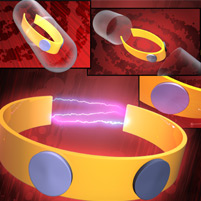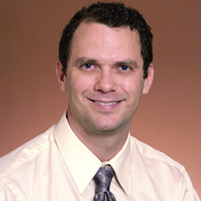Incredible Edible

Graphic demonstration of device

Jay Whitacre

Chris Bettinger
Stimulating damaged tissue, bio-sensing gastric health, targeting drug delivery and more could soon be as easy as popping your morning multivitamin — thanks to the joint work of Carnegie Mellon University's Christopher Bettinger and Jay Whitacre.
The two cutting-edge researchers have combined forces to develop edible electronic devices — no larger than ordinary pills — to improve medical care.
"It's classic Carnegie Mellon, the kind of thing that can only happen here, where you have people who are interested and excited and collaborative," noted Bettinger, assistant professor of materials science and engineering and biomedical engineering. "Jay couldn't do it without me, I couldn't do it without him. It's a great partnership."
Bettinger has been developing pioneering biodegradable electronic materials for medical use, but had a few nagging concerns.
"Two questions kept coming up," he explained. "First, how were we going to power these devices? Second, if they're degradable and temporary, then what was the best way to integrate them with the human body?"
Whitacre, associate professor of materials science and engineering and engineering and public policy, had created a revolutionary low-cost, non-toxic sodium ion battery. And with his office just two doors from Bettinger's, casual conversation spelled opportunity.
"I had claimed my device was so non-toxic that you 'could eat the battery,'" explained Whitacre. "Chris came into my office and asked, 'Can you really eat it?' The answer is yes and the rest is history — my edible battery chemistry with his need for low level power in a digestible form were a great match."
"We thought the innovation from that battery could be a great segue to medical materials," added Bettinger. "So we leveraged its advantages in a different setting."
With post-doctoral researchers Young Jo Kim and Sang-Eun Chun as part of the team, they devised a tiny, biocompatible battery in edible form that a patient could 'take' once a day.
The shape-memory polymer conceived in Bettinger's lab starts small when swallowed, then expands in the body where needed. The battery materials created in Whitacre's lab are commonly available and inexpensive — necessary for a daily device. The battery materials pass right through the system while the binding materials naturally biodegrade.
Unlike an implanted device, it's minimally invasive, and as with any orally-taken 'pill,' doesn't require sterilization. And if that weren't enough, the battery activates itself when wet, so the casing can be designed to absorb water at a pre-determined rate meaning "actual initiation would be passively engineered in the device itself," says Bettinger.
While specific applications are still in the future, it's a remarkable way to "lay the groundwork."
"It's also entrepreneurial," Bettinger added. "At the end of the day, we're engineers. The wonderful thing about CMU is that here, we're solving problems."
Related Links: College of Engineering | Materials Science & Engineering | Biomedical Engineering | Engineering & Public Policy | Read press release | Top Innovator | He Keeps Going and Going
